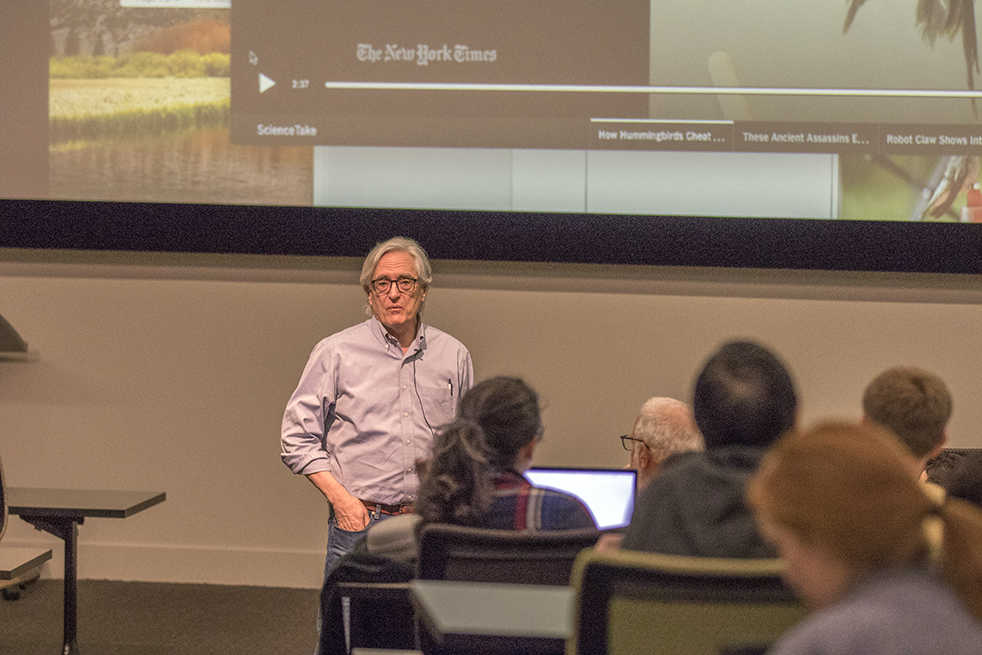A recent public lecture given by James Gorman, science writer at large for the New York Times, was titled “Sex, Flies, and Videotape: Explaining Science in Old and New Media” and enlightened attendees on the importance of and techniques behind communicating science to the public.
The lecture, held on Tuesday, March 27, was part of the “Frontiers in Science” lecture series held by the College of Sciences that features experts speaking about breakthroughs, their personal stories as well as providing some sage advice.
Gorman began his lecture by telling the audience about the many and varied experiences he has had that have lead him to where he is now. Gorman’s resume qualifies him as an expert on the subject of communicating science to the public.
He has been a writer and editor at the New York Times for 25 years, doing everything from editing a personal technology section to hosting and writing the ongoing video series “ScienceTake.” He has also written for magazines such as the New Yorker and the Atlantic.
During his lecture, he shared with students his international travels and experiences as a science reporter in the hopes of inspiring them to work hard at trying to communicate in a way that the layperson can understand, even tough engineering concepts.
“Communicating science is hugely important for the public and for anyone involved in the sciences and engineering,” Gorman said. “Translating technical information for people outside your field should be something that all professionals work at.”
Gorman went on to talk about the ways that print has changed throughout recent years, and how visual media have been introduced in combination with traditional print media forms. He showed several of the videos he has worked on and gave examples of why sometimes, videos can show things and reach audiences that long articles simply cannot.
His series “ScienceTake” does just this. It tackles technical science topics such as dueling flies and crab courtship in weekly two minute videos that draw people in by showing something they have never seen before.
The videos not only portray a scientific finding, but give an audience insight into the processes by which the discovery was made. Videos don’t have to rely on a big discovery like articles sometimes must, but can dive into more specific nuances or small but significant finds.
Gorman had a few tips for engineers and scientists that want to communicate their findings to the public. He insisted that they keep their audience in mind, shoot for simplicity over complexity, and use metaphors the audience is familiar with. He also said that communicators have to be willing to try something new, or insert a little of their own flair into their work.
“I often tend to introduce some humor into it, which I don’t think lessens the importance of the science,” Gorman said. “In fact, I think it gets people interested.”
Later, during time set aside for questions and answers, Gorman addressed the fears an audience member had that this kind of science communication simplifies information too far.
“If you deliver science in all its detail and complexity to the average person, none of that information reaches them,” he said. “They are not informed at all, because they didn’t hear anything you said. If you deliver a little tiny bit, you have informed them a little bit. The hope is that you pull them in a little bit more.”
In response to another question about the largest challenge facing science communicators, Gorman lamented the level of scientific illiteracy in the public and the disconnect between complicated, serious stories that get little attention and light, fun ones that are popular.
He had a few words for the aspiring science communicators in the room, and encouraged listeners to do as much writing and content producing as possible, and not to ignore the wide variety of media platforms available in order to reach a wider audience.
“One of the things that has surprised me as I have been doing this is that the scientists have generally been happy with what I thought was dumbed down,” Gorman said. “They’re happy because they get to reach a big audience.”
In Gorman’s eyes, any little bit of information that can reach the public is great, because it can teach them something new about the world in which they live.
